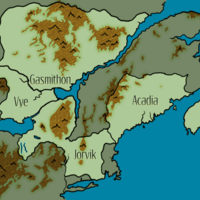Kingdom of Vye

The Kingdom of Vye is a land of thick forests, coiling mists, and deep shadow.
Its people project an eerie calm and certainty which most visitors find unsettling. All attend their duties placidly, often working communal farms or some endeavor of public works from dusk til dawn with no meaningful break. No overseer shouts them to the fields, no whip kisses their backs, no song passes their lips - only a dim smile and a nod to their fellows on passing. Mile after mile fields corn or beans or flowers, no sound out of nature but the creak of a cart or the swish of scythes.
Natives of Vye dream vividly of their labors. They dream of waking and working, then wake and work. At times the dreams are strangely clouded and their labors become obscure, but at times mists from the woods cloud their fields as well. Without interruption, the cycle of sleep and awareness slowly blends to a calm oneness, a veneration of Vye through thought and action unbroken. It is not unheard of for one to pass from life while at their task but fail to notice the distinction. Thus awake, asleep, alive, or dead, all who serve Vye serve Vye.
At the center of the land at the center of its roads is the city-cathedral Vye, an ominously splendid and sprawling work of gothic architecture, and the seat of Vye, god-king of his land. Through its streets pace the smiling red-robed merchants preparing their lord's wares for profitable trade afar, awed petitioners from the farmlands, and preening and fawning pagarchs.
Vye is not a land well-loved or well-trusted by its neighbors, but it is a signatory of the Treaty of Still Waters and obeys the letter of those laws scrupulously. In addition, the Kingdom of Vye supplies a great deal of the Land's produce, grain, and wood. Its merchants are regarded with a tinge of awe by others in the market. They broker odd barters, sometimes seemingly insane, and smilingly enter into trades others would find ruinous. Yet year after year their wealth grows, they weather storms of commerce that smash others to ruin, and their grin grows across the Lands.
Follow Vis Major's board Vye on Pinterest.
Daily Life
To a visitor, the fare of the Kingdom of Vye seems exceedingly bland. Breads are small, unfilled buns, vegetables are steamed, meat is rare, and the most common dish is a simple thick stew of grain and beans served from a large communal pot. When the host places the sauce service, this perception rapidly changes.
The Vyese pack all the flavor and flair of their meals into their sauces, relishes, and spreads, which are served from numerous small bowls on a large central platter. Many of these are based on extremely hot chili pastes which can surprise the unwary. Hints of mint, nasturtium, and violets touch off the fire. Other flavors run towards sweet and salty or pungent. Delicate floral salads are served in lieu of dessert.
The towns are simple, austere, and ascetic, mostly low wooden buildings of mixed and common use. They tend be tightly clustered around a central square or well, and can surprise a traveler coming along a well-maintained road through the dense woods. The exceptions to this utilitarian presence are the white-on-crimson cameos showing the silhouette of the land's unquestioned ruler.
This decorative concession is slightly mirrored in their clothes - though most common is a simple, long tunic and short-legged slacks of raw, pale hivespun, an outfit usually incorporates a hood, scarf, or belt died in rose madder or sumac. Braided belts, low-cut shoes, and cloaks are leather and insulated with hivespun fleece linings during the winter and rain. Citizens usually bear an elaborate array of tiny charms about their neck or wrist, or braided into their hair, each passed down from an ancestor or a reward from a council for notable service or a great deed. A rich crimson cameo of Vye is a common icon, as well.
Literacy in Vye is very low, but the population has an uncanny grasp of mathematics. Formal education is built into the monthly festival days, where older children lead the younger in folk songs which teach mnemonic and memory-theater tricks interspersed with hymns.
